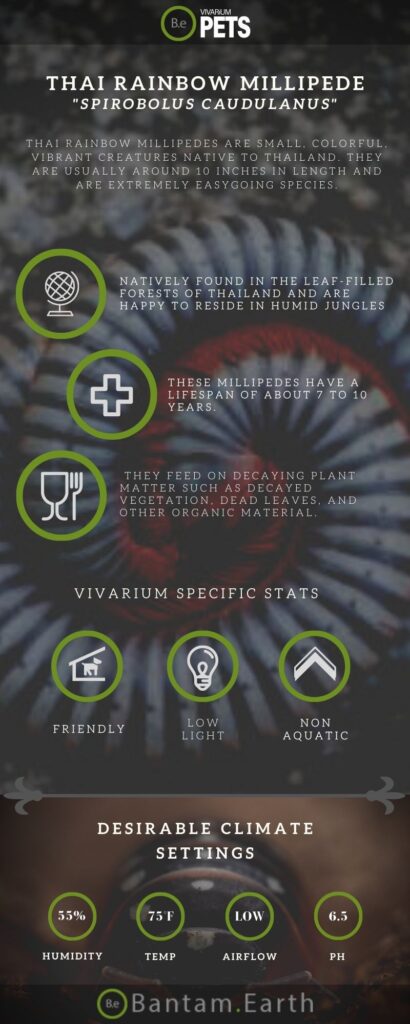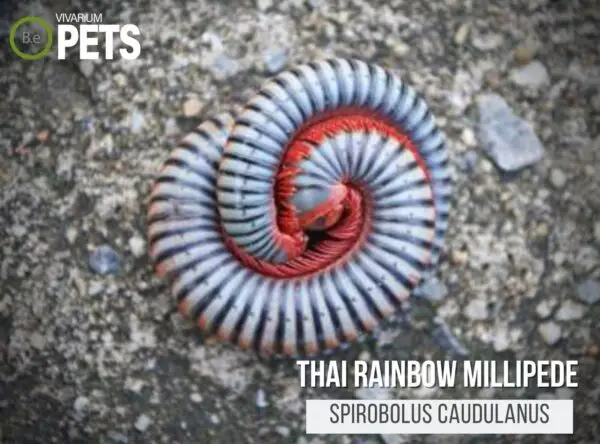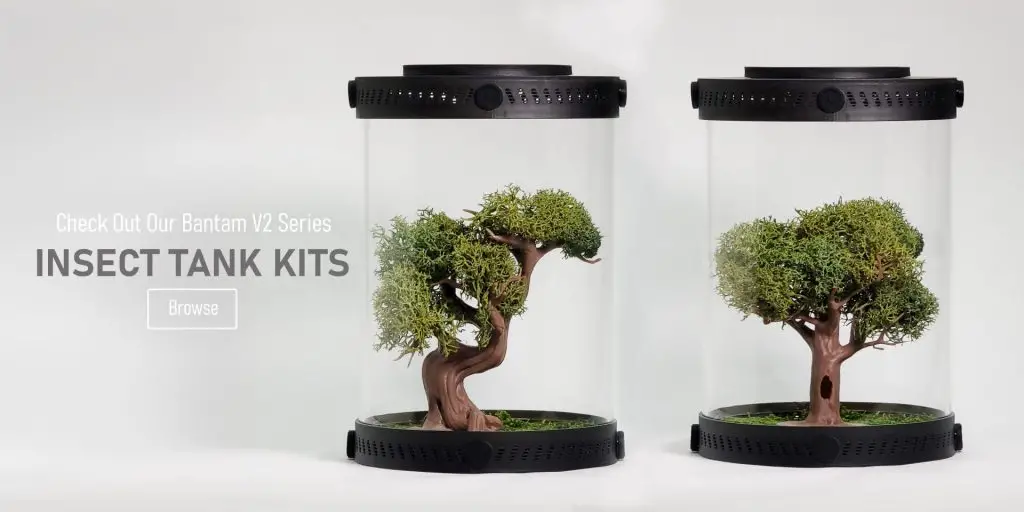If you can get your hands on a Thai Rainbow Millipede (Spirobolus caudulanus) the hardest part of having them is already done!
These fascinating little creatures are both beautiful and great companions.
This guide will provide you with all the information you need to provide the best possible care for the colorful giant millipede.
We’ll cover topics such as ideal tank setup, the best diet, how to handle it, and more!
By the end of this article, you will be ready to give your pet the best care. So let’s dive into it!
Table Of Contents:
ToggleWhat Are Thai Rainbow Millipedes?
Thai Rainbow Millipedes are endemic to Southeast Asia and are famously known for their remarkable colors.
The common name comes from the colors that appear on their bodies as each segment has bright colors in a rainbow pattern.
They are considered giant millipedes and have stout and segmented bodies, which allow them to curl up if threatened.
Create an ideal habitat for your millipede with our Customizable Millipede Enclosure Kits, which include everything you need to get started.
What Do Thai Rainbow Millipedes Look Like?
Thai Rainbow Millipedes are small, colorful, vibrant creatures native to Thailand.
They are usually around 9-10 inches in length and have beautiful, dazzling colors of yellow, orange, red, and black.
Their bodies are made up of numerous segments and each body segment is covered with overlapping plates which provide them with protection.
They also possess two pairs of antennae as well as two pairs of legs which help them with movement.
The legs can come in different colors, ranging from yellow, orange, and even purple.
The head of the millipede has two sensory organs on each side for use in exploring its surroundings.
Additionally, the millipede has specialized pincers which are used to grasp food, as well as two short appendages that it uses to detect chemicals.
Benefits Of Using Thai Rainbow Millipedes
Thai Rainbow Millipedes are terrific additions to vivariums due to their distinctive coloration, peaceful nature, and relatively neat tendencies.
These millipedes look amazing when kept in a setup with live vivarium plants and other decorations.
Additionally, these millipedes are non-aggressive and non-venomous, so you can safely handle and observe them without fear.
They also require very low maintenance compared to other pets, as they don’t need to be fed every day or need any special grooming.


Thai Rainbow Millipede Facts
Thai Rainbow Millipedes are scientifically known as Spirobolus caudulanus which is an update from previously being labeled Apeuthes spp.
They feed primarily on decaying organic matter, such as leaves and bark, but can also eat fresh things like fruits, pet foods, and other small insects.
Their average lifespan is relatively long for millipedes, and the breeding season for these millipedes starts in the early months of the year.
Habitat
The Thai Rainbow Millipede is a species of millipede native to Southeast Asia.
They are natively found in the leaf-filled forests of Thailand and are happy to reside in humid jungles, where they hide between fallen logs and leaves.
As Spirobolus caudulanus prefers warm and moist areas, they are more active during the day than other species of millipedes.
Replicate their natural habitat perfectly with our Bioactive Millipede Substrate Blend, designed to provide the ideal moisture and organic content for your millipedes.
Diet
In their natural habitat, Thai Rainbow Millipedes feed on decaying plant matter such as decayed vegetation, dead leaves, and other organic material.
They use their long antennae to help them identify potential sources of food.
Spirobolus caudulanus also feeds on small invertebrates like insect larvae and other small creatures.
Their ideal diet is compromised of small pieces of natural foods such as pieces of available soil-based organic material mixed with organic protein sources, such as small pieces of fruit, vegetables, and insects.
Temperament
When it comes to dealing with humans, Thai Rainbow Millipedes have a surprisingly gentle temperament.
These creatures tend to be non-aggressive and non-toxic, and as such, they make great pets!
They are not shy or skittish around people and will allow you to pick them up with ease.
They are particularly attracted to humans who show a calm and gentle demeanor toward them.
When it comes to interacting with other animals, they usually keep to themselves and do not tend to be aggressive or predatory.
They are, however, very social creatures, so they will typically search out the company of other millipedes when living in an enclosure.
As long as they have plenty of space and hiding places, they get along very well with other animals in their environment.
Lifespan
The life expectancy of Thai Rainbow Millipedes is between seven and ten years, depending on proper care and environmental conditions.
They reach adulthood when they are approximately a year old.
They go through several life stages from the egg stage to adulthood.
Once adulthood is reached, the Rainbow Millipedes work on developing their unique coloring.
Their coloring is believed to be special for two reasons – its ability to help them blend into their environment and its potential use as a form of communication.
As juveniles, the millipedes are generally yellow. As they age, yellow gives way to a variety of colors including orange, red, green, and blue.
Breeding
Spirobolus caudulanus reproduces through courtship and mating.
During courtship, the female will display her bright colors and twirl her antennae to attract a mate.
When she has successfully attracted a partner, he will place his antennae on her antennae to indicate consent.
Once mating has occurred, the eggs will be deposited in a nesting space provided by the female for incubation.
The eggs are about 4-5 mm in size and are oblong. They are typically light yellow or pale orange.
Where To Find Thai Rainbow Millipedes
Thai Rainbow Millipedes are originally from Thailand, hence their name. So be ready to travel if you’re looking to catch these critters.
For those who want to buy Thai Rainbow Millipedes, they can be found in some pet stores that specialize in rare invertebrates.
It is important to check the reputation of the breeder to ensure they provide the best quality specimens.
Thai Rainbow Millipede Care
Thai Rainbow Millipedes require an appropriate tank environment and diet.
For their tank, they need proper terrarium substrate bedding, heating, lighting, and ventilation.
They should be fed a high-fiber diet that is balanced with variety.
They should always be handled gently with clean hands.
Regular cleaning and checking for health concerns are recommended to ensure their well-being.
With the proper care, your pet Spirobolus caudulanus will be a healthy and happy companion.
Tank Requirements
The ideal tank for Thai Rainbow Millipedes should be made up of a 10-20 gallon tropical terrarium or paludarium with good airflow.
It is important to keep the pH level between 6.5-7.5 and the hardness between 10-15 dGH.
This species likes moist and humid environments, so it should be kept at temperatures of 75-85 degrees Fahrenheit.
The substrate should be a combination of peat moss, coco coir, and vermicompost soil that is moistened with a spray bottle.
It is also important to provide indirect lighting with a day/night cycle. Fluorescent bulbs or LEDs that produce 10,000-12,000 Lux are best.
What Do Thai Rainbow Millipedes Eat?
As an owner, it is important to provide your Thai Rainbow Millipede with enough food and nutrition to keep them healthy and active.
To give your millipede the best nutrition, feed it a variety of foods to ensure they are receiving a balanced diet.
To supplement its diet, you can also provide it with calcium-rich foods such as cuttlefish bone, boiled egg shells, or crushed egg shells.
Below is a list of recommended food items for your Spirobolus caudulanus:
- Vegetables: Carrots, squashes, cucumbers, corn, sweet potato
- Fruits: Apples, bananas, pears, mangoes
- Protein-rich food: Flower worms, crickets, snails, earthworms
- Calcium-rich food: Cuttlefish bone, boiled eggshells, crushed eggshells
When offering your Millipede food, remember to give only enough that it can finish in one feeding session.
This helps to reduce the possibility of food spoiling and molding.
Also, if you can, give your colorful critters fresh food instead of the canned or frozen variants as they tend to be healthier.
Above all, providing the right nutrition for your pet Millipedes is key to their health.
If you’re more of an avid hobbyist like myself, check out my ultimate DIY Millipede food guide. I explain the best foods and my favorite recipe in more depth.
Best Tankmates For Thai Rainbow Millipedes
When it comes to choosing tankmates for your Thai Rainbow Millipedes, it’s important to make sure that the other animals have similar environmental needs.
Tankmates such as large slow-moving invertebrates, living in the same small ecosystem, can be beneficial for the millipede.
Some of the best tankmates for the Spirobolus caudulanus include species of snails, earthworms, isopods, and springtails.
These species tend to have similar temperature, humidity, and dietary needs as the Spirobolus caudulanus.
These species tend to prefer the same temperature and humidity range as the fruitful scavenger and can help provide an added layer of natural cleaning to the tank.
Conclusion
Providing the best possible care for your Thai Rainbow Millipede friend is easy when you know what their needs are and how to meet them.
By following this guide, you will be able to keep your Spirobolus caudulanus happy, healthy, and safe.
With the right care and attention, you’ll have a wonderful pet millipede to enjoy and admire for many years to come.
Create the ideal habitat for your millipedes with our species-specific soil mixes and Insect Enclosure Kits. These products provide everything you need for a successful and thriving millipede colony.
Frequently Asked Questions
Even though Thai millipedes (Spirobolus caudulanus) are not poisonous, they may sometimes secrete a fluid that can cause skin irritation if touched or handled. This fluid, known as “repugnatorial secretions,” contains several active compounds such as benzoquinonoids that can cause skin irritation and a burning sensation. It is best to be cautious and avoid touching or handling these millipedes whenever possible.







